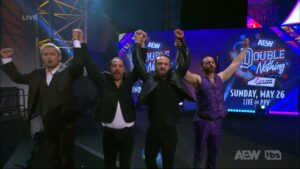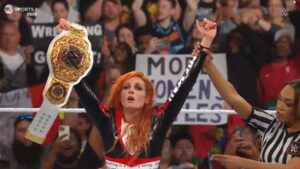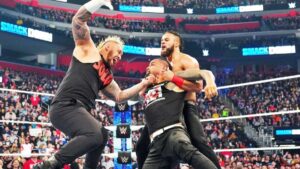The eighth part in our 10-part series looking at 150 Canadian names in pro wrestling, in honour of Canada’s 150th birthday. Part 8 of the Canada 150, an alphabetical listing of Canadians’ impact on pro wrestling from the 1920’s to today.
ROSEMARY

Winnipeg’s Rosemary began her trek into pro wrestling when she moved to Windsor, Ontario to train with Scott D’Amore, Tyson Dux and Johnny Devine at BCW’s Can-Am School in 2007. She debuted in 2008 as PJ Tyler, but soon settled on Courtney Rush as her wrestling persona. She worked the Ontario and Quebec circuits before joining SHIMMER in 2010. She would spend six years in SHIMMER, winning Tag Team gold with women’s legend (and current WWE Producer Sara Del Rey), as well as continuing in the Canadian independent scene with the likes of Smash Wrestling. Over the decade, her Courtney Rush character morphed from a fun loving face to a twisted lunatic by the end. It was this dark side that drew her to TNA where she was packaged in The Decay, a trio of demented warriors featuring Abyss and Crazzy Steve. Her recent 266 day reign as Impact Knockouts Champion was the second longest reign in GFW/Impact/TNA history – only Taryn Terrell‘s 279 day reign from 2014 to 2015 outlasted her. With the Decay no more and Rosemary hearing the voice of the Hive, expect Rosemary to be a focal point of Global Force Wrestling’s women’s division for years to come.
THE ROUGEAU FAMILY

The famed Rougeau family of Montreal, Quebec actually began with Eddie Auger, who wrestled as Pierre Lasalle, in the early 1940’s. He would soon switch back to his real name and became the first French-Canadian to tour the world performing. Two of his nephews, Jean Rougeau and Jacques Rougeau Sr., would follow in his path of professional wrestling – Jean would wrestle as Johnny Rougeau, debuting in 1951, and in 1956, his brother Jacques Rougeau Sr. would join him. They became huge stars in the strong Montreal circuit. Johnny Rougeau would go on to become one of Montreal’s top promoters, running the IWA in Montreal, as well as becoming a coach and later president of the QMJHL, Quebec’s top minor hockey league (the Jean Rougeau Trophy for the team with the most points is named after him). Three of Jacques Rougeau’s sons would also go on to become professional wrestlers – Jacques Rougeau Jr., Raymond Rougeau and Armand Rougeau.
JACQUES ROUGEAU

Jacques Rougeau Jr. debuted in 1977, working with Quebec promotions until joining Stampede Wrestling as well as several NWA territories, Rougeau became a solid worker throughout the territories in the late 70’s and early 80’s. In 1985, he and his brother Raymond were signed to the WWF as The Fabulous Rougeau Brothers and immediately became big players in the WWF tag team scene, facing the likes of The Hart Foundation, The Dream Team (Brutus Beefcake & Greg ‘The Hammer’ Valentine) and The Funks (Dory Jr. & Terry). In 1987, they turned heel by becoming “American citizens” and aligning with Jimmy Hart. As heels, the remained strong contenders in the tag team division until Raymond retired in 1990. In 1991, Jacques was repackaged as a singles wrestler and probably his most famous gimmick, that of The Mountie. His greatest singles success in the WWF would occur when he beat Bret ‘Hitman’ Hart for the Intercontinental title in 1992. In 1993, he was paired with Carl Ouellet in a new tag team, The Quebecers, and the duo would become 3x WWF World Tag Team Champions. In 1996, he and Ouellet went to WCW, where they were The Amazing French Canadians, but in 1998 they returned to the WWF for a brief stint, before Rougeau retired. He now runs a wrestling school in Montreal.
RAYMOND ROUGEAU

The older brother of Jacques Rougeau Jr., Raymond Rougeau made his debut in 1971 at the age of 16, competing in his father’s IWA and other Quebec and Canadian promotions. In 1976, he moved to Atlanta, Georgia and became a regular worker in the NWA territories until he joined his brother in the WWF in 1985 as the Fabulous Rougeau brothers. Following his retirement in 1990, Rougeau would become the WWF’s French-speaking colour commentator for it’s French broadcasts, a position he would hold until 2002 (WWE stopped producing French language editions of broadcasts). Earlier this year, when the WWE began producing French language content once again, Rougeau was rehired and currently works for the WWE once again.
HANS SCHMIDT

Quebec’s Guy Larose debuted in 1949 and is widely credited as being the first Nazi German gimmick in pro wrestling. While working for a Boston territory in 1951, Larose was renamed Hans Schmidt and played on the anti-German sentiment that still lingered in North American emotions following the Second World War. He worked the crowd with anti-American comments, riling the crowd into bloodthirsty hatred. During the early days of wrestling on television in the 1950’s, Schmidt became one of TV’s biggest wrestling heels in the country, laying the groundwork for such future foreign heels like Fritz Von Erich and The Iron Sheik. He would become a classic nemesis to many top champions and draws, feuding over his career with Lou Thesz, Whipper Billy Watson, Verne Gagne, and “Nature Boy” Buddy Rogers (Schmidt’s heel heat was so immense that when he faced Rogers, another heel, he instantly turned Rogers face by merely being against him). Schmidt retired in 1976, as one of the most influential and hated “foreign heel” gimmicks of all time.
GEORGE SCOTT

Hamilton, Ontario’s George Scott debuted in 1948 on the Ontario circuits, including working for Maple Leaf Wrestling. He impressed early and in his early years, he would face Gorgeous George and Buddy Rogers in early singles matches. He would begin working with the NWA territories shortly after and became a rising star in Georgia and the Carolinas. Following a match with Rogers in 1952, he suffered three ruptured discs in his back and was advised to retire from professional wrestling. Instead, he took a year off and returned in 1954, this time bringing in his brother Sandy Scott, and heading to Stampede Wrestling as the popular tag team, The Flying Scotts. The tag team would dissolve by 1960, but George continued to be a huge singles star, both in Stampede Wrestling and Jim Crockett‘s Mid-Atlantic territory in North Carolina. By the early 1970’s, with his career winding down, Scott became a booker with both promotions as well. Scott earned a solid reputation as one of the best bookers in the NWA and his keen eye for talent launched many future Hall of Famers careers (or shifted them onto better trajectories) – during his time with Mid-Atlantic in the early 1970’s, he’s credited as being the man who brought Ric Flair, Roddy Piper, Jimmy Snuka and Ricky Steamboat from smaller promotions where they were being underused and turning them into Superstars. In 1983, he joined the WWF and became one of Vince McMahon Jr.’s chief negotiators, overseeing the buyout of Georgia Championship Wrestling‘s timeslot on TBS as his first task, and then working out the purchase of Stampede Wrestling in 1985. He set up WWF’s first drug testing policy and helped the WWF launch Saturday Night’s Main Event, but he began to clash heads with WWF’s biggest star, Hulk Hogan. He left the WWF in 1986 and went to work for WCCW in Texas in creative for two years, before returning to Mid-Atlantic in 1988. He retired from the industry in the early 1990’s.
“IRON” MIKE SHARPE

Another resident of Hamilton, Ontario, “Iron” Mike Sharpe debuted in professional wrestling in 1973, a second generation grappler preceded by his father and uncle, Mike & Ben Sharpe, who were huge tag team stars from the 1950’s. Trained by Dewey Robertson (aka The Missing Link), “Canada’s Greatest Athlete” became a star in the Canadian territories, principally in Vancouver with All-Star Wrestling. He also ventured into various NWA territories. In 1983, he signed with the WWF and initially had some real momentum – he faced then WWF World Champion Bob Backlund several times. But Sharpe’s place on the card slowly diminished and he became one of the most well known enhancement wrestlers in history (or jobbers). He would continue in that role with the WWF until 1995. He returned to indie promotions for a couple years, before retiring in 1997. Sadly, “Iron” Mike passed away last year from illness at the age of 65.
GAMA SINGH

Originally from Vancouver, Gama Singh moved to Calgary in the early 1970’s to train with Stu Hart. In 1973, he debuted with Stampede Wrestling. As an arrogant foreign heel gimmick, Gama Singh would become one of the most heels in Stampede history, but the man had talent. He had a stellar feud with The Dynamite Kid, en route to becoming a 6x World Mid-Heavyweight Champion (Stampede’s Cruiserweight title). He also worked overseas, touring NJPW several times (usually in a tag team with Tiger Jeet Singh) and in the Caribbean with WWC. In the 80’s, he signed with WWF part-time, working overseas tours mostly in the Middle East and surrounding region, although he did make some WWF TV appearances. He retired from wrestling in the early 90’s. His nephew has since gone on to great heights in the WWE Universe – Gama Singh is the uncle of current WWE Champion, Jinder Mahal.
TIGER ALI SINGH

The son of wrestling legend Tiger Jeet Singh, Toronto’s Tiger Ali Singh debuted in 1992, initially training with Ron Hutchison and Sweet Daddy Siki before heading to the NJPW Dojo in Japan. He wrestled for Frontier Martial-arts Wrestling (FMW) early on, before signing with the WWF in 1997. He debuted as an arrogant wealthy character (complete with his man-servant Babu) but the character never properly took off. In 2000, he became a manager, managing Lo Down (D’Lo Brown and Chaz from the Headbangers), before being released in 2002.
TIGER JEET SINGH

As a teenager, Tiger Jeet Singh emigrated from India to Toronto to learn to become a professional wrestler. He was trained by Fred Askins, one of the top trainers for Maple Leaf Wrestling, and made his debut in 1965. He soon became a top level heel and in 1967, he faced NWA World Heavyweight Champion Gene Kiniski as well as WWWF World Heavyweight Champion Bruno Sammartino on multiple occasions. In 1971, Tiger Jeet Singh main evented the first wrestling show to sell out Maple Leaf Gardens, as 18,000 fans paid to see him fight The Sheik. In 1973, he went to Japan and became a huge star with NJPW. In 1975, he defeated NJPW Legend (and founder) Antonio Inoki for the NWF Heavyweight Championship (the precursor to the IWGP Heavyweight title). In 1981, he jumped to rival All-Japan for the rest of the decade, before returning to NJPW in 1990. He still wrestles throughout Japan (although much less regularly), where he is a legend of puroresu.
THE SINGH BROTHERS

Real life brothers – Harv and Gurv Sihra – debuted in the early 2000’s, after training with Harley Race, Rip Rogers and in the Hart Dungeon. They began with their hometown ECCW in Vancouver, becoming 5x ECCW Tag Team champs as The Bollywood Boyz. In 2011, they were signed by TNA to work exclusively for their India promotion, Ring Ka King, until the promotion closed a year later. That connection led to signing with Jeff Jarrett‘s Global Force Wrestling in 2015, where they became GFW’s inaugural tag team champions. The following year, they were both selected to take part in the WWE’s Cruiserweight Classic and following the tournament, signed with NXT. They spent most of the last year on NXT and 205 Live, before being repackaged as The Singh Brothers and siding as the henchmen to WWE Champion Jinder Mahal.
SINN BODHI

Another part of the Orangeville, Ontario contingent (along with Edge and Christian), Sinn Bodhi trained in Toronto with Ron Hutchison and debuted with his Apocalypse Wrestling Federation in 2000. In 2003, he joined TNA under the name Sinn as part of Father James Mitchell‘s Disciples of the New Church, but the run was short lived. He joined WWE in 2006 and began working in their developmental as Sinn Bowdee. In early 2009, after weeks of vignette hype, he debuted on the main roster as the freakish Kizarny. But after all the build up, including a debut victory over MVP, he was released shortly after. He returned to the indies and has remained a presence ever since, working with CHIKARA, WWC, PWG and many other promotions, including his own Freakshow Wrestling out of Las Vegas, started up in 2011.
SKY LOW LOW

For decades, Montreal’s Sky Low Low was arguably the most famous and popular midget wrestler in the world. Trained and managed by Jack Britton for the majority of his career, he travelled the world and most of the territories in a career that started in the 1940’s and spanned 40 years. He was still making appearances for the WWF in the 1980’s. He died in 1998, at the age of 70.
DAVEY BOY SMITH JR.

Calgary’s Harry Smith has gone by several names in his career, but currently he’s known as Davey Boy Smith Jr., an homage to his father, legendary WWE Superstar “The British Bulldog” Davey Boy Smith. Trained at a young age in the Hart Dungeon, he made his debut with Stampede Wrestling in 2000, teaming with Tyson Kidd in The Stampede Bulldogs, and then forming the Hart Foundation V.2.0, a stable that included his cousin, Teddy Hart, and fellow Dungeon grads Kidd and Jack Evans. In 2004, he was offered a developmental deal with the WWE, but turned it down to work Japan instead. He spent much of 2005 working with NJPW, but returned in 2006 and finally signed with WWE. He was initially paired with Teddy Hart as a tag partner, with his cousin Natalya managing, called the Next Generation Hart Foundation, but Teddy was soon released and Smith was elevated to the main roster in 2007 as a singles wrestler. Renamed DH Smith (the DH stood for David Hart), he had a sporadic run of appearances, until he was repackaged with Tyson Kidd in The Hart Legacy, with Natalya managing the team. Despite becoming 2x World Tag Team Champions in the WWE, he was released in 2011. He returned to NJPW in 2012, immediately joining the Suzuki-Gun faction lead by Minoru Suzuki, and teaming up with Lance Archer in the Killer Elite Squad. They soon became one of Japan’s most dominant tag teams, winning the IWGP Tag Team titles twice, as well as capturing Pro Wrestling NOAH‘s GHC Tag Team titles twice during the NJPW invasion where Suzuki-Gun spent two years in “exile” in NOAH. With the Killer Elite Squad on hold due to an injury to Archer, Smith has been travelling the world working for multiple indie promotions, as well as remaining part of NJPW.
SPACE MONKEY

Toronto’s unorthodox Space Monkey combines a great comedic element (that of an actual simian cosmonaut) with great aerial wrestling. Starting out in Ontario indies like Superkick’D, Alpha-1 and Smash Wrestling only a few years ago, he’s since become one of North America’s rising young stars – in the past year, he’s competed for AAW, AIW, WrestleCircus, Glory Pro, Tier 1, Beyond and more, not to mention winning the Young Lions Cup in CHIKARA earlier this year.






